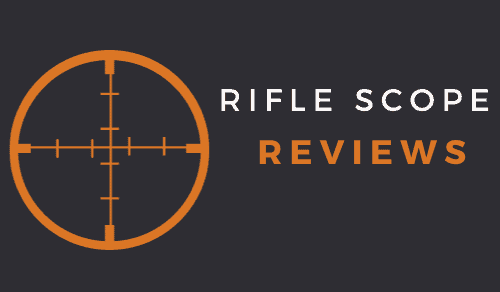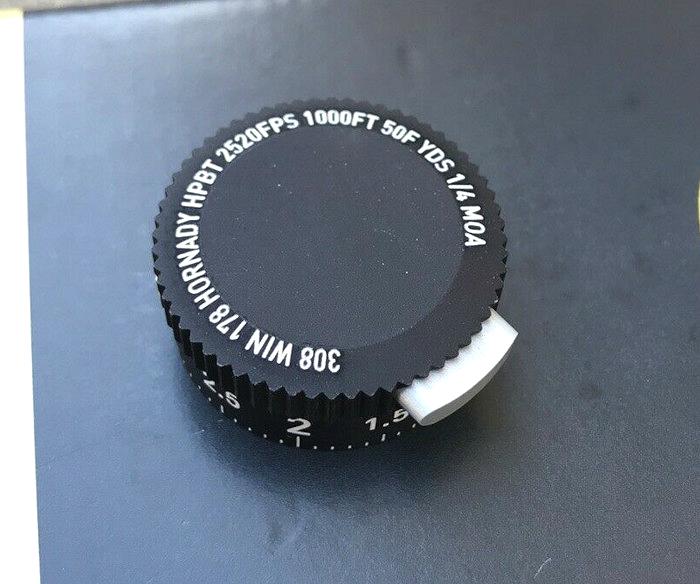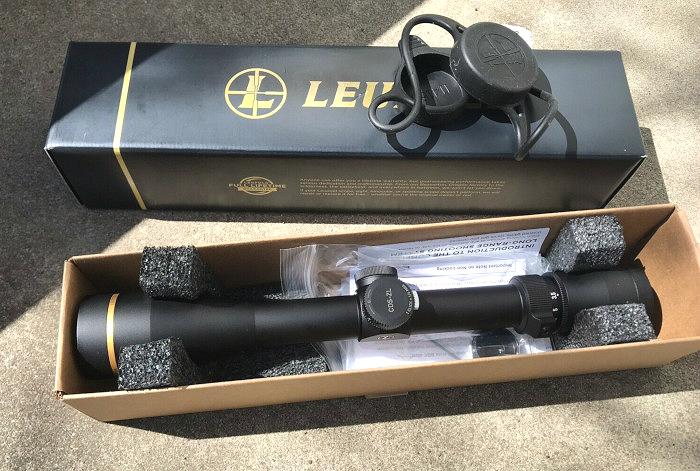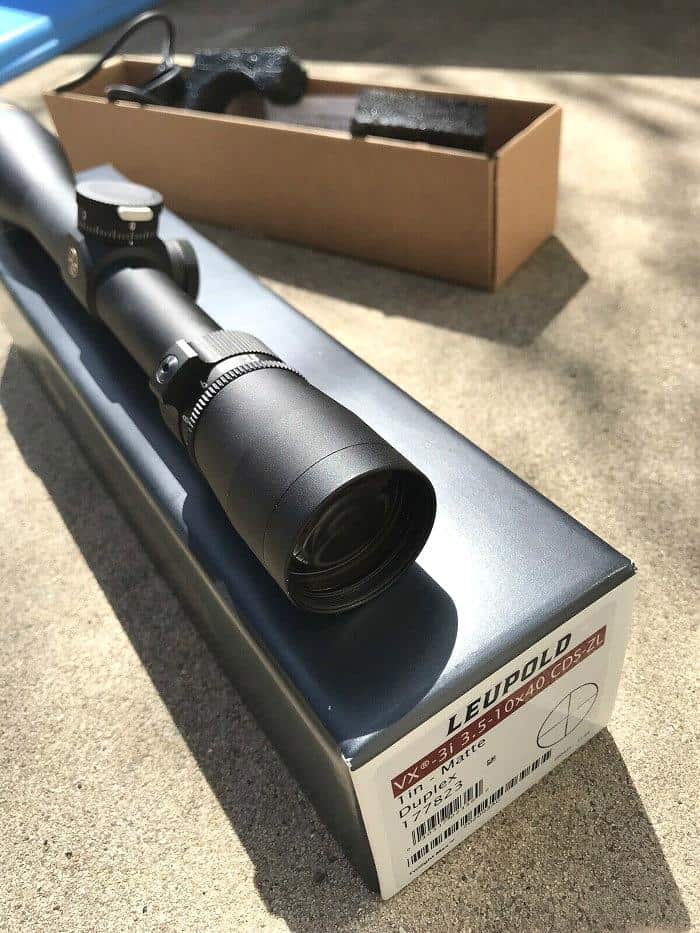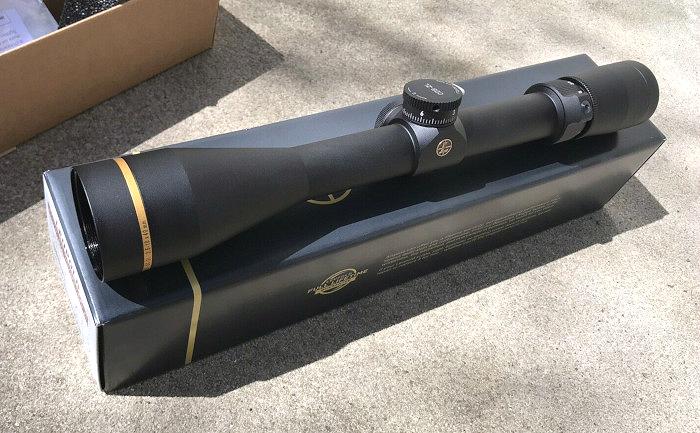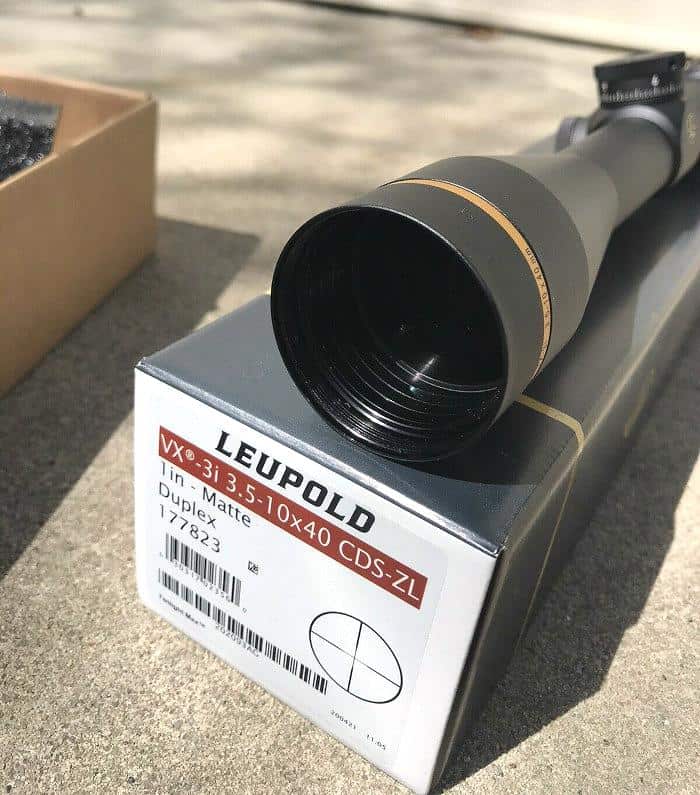As an Amazon Associate I earn from qualifying purchases. Amazon and the Amazon logo are trademarks of Amazon.com, Inc, or its affiliates.
I recently received the following email from a site visitor concerning an issue with a Leupold CDS turret. As he and I went back and forth via email, I realized that it might make sense to put some of my responses down on paper. Especially since I’m typically asked at least one or two CDS-based questions at my day job each month, I thought I’d take the time to put my answers on paper (so to speak). In this post, I’ll be looking at some of the common Leupold CDS dial problems and some of the common solutions to those problems.
The question I was initially sent via email was this, and it’s been published here with the site visitor’s permission:
“I have a Leupold VX3-HD scope with the CDS dial option. I ordered the one free custom dial from Leupold, using the necessary rifle/bullet information that they require. However, when using the CDS dial at distances beyond the 100-yard sight-in distance, the point of impact isn’t even close to the point of aim. Have you dealt with the Leupold CDS system, and do you have any suggestions to correct the issue?”
He and I went back and forth via email several times, and we were able to troubleshoot the issue through some question-and-answer emails (his issue was actually related to one of the common problems that I discuss below).
Leupold CDS Dial System Overview
The Leupold CDS system is a custom turret system configured to a specific caliber using required data points (and I’ll discuss each of the necessary data points in deeper detail below). The turrets are built to include the required bullet drop of the caliber at specific distances.
The CDS portion stands for “Custom Dial System,” and it’s primarily a BDC-based turret system that allows for pre-configured bullet drop at certain distances.
Once configured and zeroed in, the turret is turned to the specific distance to the target, and then the reticle is placed on the target for shooting. Again, all the ballistic math is pre-configured, so the bullet drop points are built into the turret dial.
Here’s a more real-world example of how the CDS system should work. Let’s say that you have a Remington 700 rifle chambered in .270 Winchester, and you order a Leupold scope equipped with the CDS dial option. You provide all the required information for the dial configuration, and Leupold ships you the custom dial turret. You install the CDS dial and sight the rifle at the 100-yard sight-in distance you provided Leupold. Now when shooting, you can turn the CDS dial to the desired range to the target, and the necessary bullet drop for the .270 Winchester with your preferred ammo is built into the dial. If everything is configured correctly, you would put the reticle on the target at a specific distance and hit the mark.
Data Needed for the CDS Turret
The required ballistic data points serve as the basis of information that makes the dial system work. The CDS generally functions like clockwork if you provide Leupold with accurate data points. However, if you provide invalid or incorrect data points, the CDS dial will be entirely off, resulting in some serious frustration and wasted ammo.
Each Leupold scope equipped with the CDS dial option is eligible for one free CDS dial. Additional CDS dials can be purchased for $80 each (at the time of this post).
Something worth pointing out: You should already have selected the desired ammunition brand and bullet grain that shoots well in your rifle. Your choice of ammunition will be the basis for answering all the necessary ammunition-related data Leupold requires.
Here is the required ballistic information that Leupold needs to build a CDS dial:
Caliber
The caliber information is pretty straightforward and refers to the specific caliber of the rifle. Therefore, it’s essential to be thorough with the caliber and provide the complete caliber.
For example, if you indicate that the caliber is a .270 Winchester but actually have a .270 Winchester Short Magnum, the BDC data on that dial will be completely incorrect.
Brand and Bullet Type
This question asks you to specify the specific bullet brand and specific bullet type. Typically, this information can be pulled straight off the ammunition box or label. However, the bullet type is confusing for some shooters, so I suggest pulling the information right off the ammunition label or calling the ammo manufacturer to confirm.
Bullet Weight
This question refers to the weight of the bullet in grains, and this information is typically listed on the outside of the ammunition or cartridge box or label.
Ballistic Coefficient
The ballistic coefficient is a numerical measurement of the amount of drag on the projectile proportional to its mass which impacts the flight characteristic of the bullet.
Without getting far into the scientific weeds, most ammunition brands utilize the G Model for determining ballistic coefficient (commonly called bullet B/C or bullet BC). Within the overall G Model, there are several G based models for determining the ballistic coefficient, and they include:
- G1
- G2
- G5
- G6
- G7
- G8
- GL
The two most popular G models used by most ammunition makers are the G1 and G7 models.
Leupold prefers to use the G1 ballistic coefficient data for use with the CDS dial.
The G1 BC data is normally available from the ammunition manufacturer or from the actual bullet manufacturer (if you’re reloading).
Actual Muzzle Velocity
The key term in this necessary data point is the word “actual.” For the best accuracy, Leupold asks for the actual muzzle velocity of your specific round of choice being fired from your particular rifle.
The best way to determine this data is by firing rounds of your chosen ammunition through your rifle and recording the muzzle velocity. For example, I prefer to shoot ten shots and then pull the average muzzle velocity of those ten shots. That average muzzle velocity is the speed I provide to Leupold for the CDS dial.
Most ammunition makers will provide an “average” muzzle velocity number for each round if you don’t have access to a chronograph. But, again, this is an average number and may or may not be all that accurate for your specific rifle since many variables affect muzzle velocity.
If at all possible, I’d recommend using the chronograph approach as it provides the best results.
Average Altitude
This information point refers to the average altitude of the location where you’ll be shooting or hunting. The average altitude information of a specific area is relatively easy to locate online.
Altitude differences can absolutely impact accuracy. I’ve seen altitude changes of 400 feet change the point of impact significantly. However, the change wasn’t enough to cause an accuracy issue with big game species but would potentially be an issue for a smaller game species or long range shooting.
Average Temperature
This data point asks for the average temperature of the area where you’ll be shooting or hunting. I recommend giving this answer some thought, especially if you’re ordering a CDS dial for a specific hunting trip.
For example, if you live in Florida but are ordering a CDS dial for an upcoming Alaskan hunting trip, using the average temperature for Florida may cause an accuracy issue in the colder Alaskan temperatures.
Sight-in Zero
The necessary information for this data point will be the specific distance you plan to use for sight-in. For most hunters and shooters, this is 100 yards, but it can vary.
If you’re using a CDS dial for a rimfire (and you absolutely can), then the sight-in distance may be 50 yards or less.
Sight Height
The sight height information is another area where the requirements are not all that clear. To clarify, Leupold is asking for the height (in inches, preferably) from the bore axis of the rifle to the bore axis of the scope.
My preferred way to provide this measurement is to measure from the center of the bolt (or barrel if you have something other than a bolt action rifle) up to the center of the riflescope.
Common Leupold CDS Issues & Solutions
Here are some of the most common CDS dial problems or issues that I’ve encountered, along with potential solutions to correct the issue. Note that these are just the most common issues that I’ve personally been involved with or experienced, so there are definitely other potential CDS dial issues that could impact the accuracy as well.
Incorrect or inaccurate muzzle velocity
I briefly touched on this issue above, but let’s dive a little bit deeper into the problem.
As I mentioned before, Leupold is asking for the “actual muzzle velocity,” so the accuracy of this information is vital for the CDS to function correctly and accurately.
Most shooters seem to go wrong in this area by providing Leupold with the “average” muzzle velocity as stated by the ammunition provider versus physically shooting the rifle through a chronograph.
There are several variables or conditions that can impact the muzzle velocity and result in a significant difference in actual muzzle velocity compared to the average muzzle velocity. Those factors include:
- The rifle barrel length
- Use of a muzzle brake or suppressor
- Aftermarket barrel porting
Your best bet is to shoot the rifle (with your desired ammunition for use with the CDS dial) through a chronograph and use that data as the actual muzzle velocity.
Changing ammunition brands from the original CDS data
I’ve seen several cases where the scope owner changed from one ammunition brand to another brand but kept shooting the exact bullet grain, believing that the CDS data provided to Leupold would still be valid. Unfortunately, it was not as different ammunition performs differently from rifle to rifle.
Even with the same bullet type and bullet grain weight, changing ammunition brands generally results in different ballistic performances. The muzzle velocity can vary due to the different powders used and the different powder characteristics. If you are a reloader, you know what I’m talking about.
My suggestion would be one of the following:
- Change back to the ammunition that you were initially using when the CDS dial turret was ordered.
- Start over with the new ammunition and order a new CDS dial with the new ammunition data points.
Incorrect sight height data
Incorrect sight height information is another area where I’ve seen some measuring inaccuracies that led to CDS accuracy problems.
In most of those cases, the scope owner used the scope ring height as the sight height basis, resulting in an incorrect sight height measurement. In addition, using the scope ring height fails to account for the total distance from the center of the rifle core to the center of the scope.
As mentioned previously, to solve that issue, I prefer to take a measurement from the middle of the rifle bore up to the middle of the mounted riflescope.
Not sighting in the scope after the CDS dial is installed
I’ve also seen a few situations where the scope owner sighted the Leupold scope and rifle in, ordered and received the CDS dial, then didn’t sight the rifle back in once the CDS dial was installed.
Once the CDS dial turret arrives and is installed on the scope, you’ll need to sight the rifle in again using the sight-in distance you specified for the CDS dial.
Using the G7 ballistic coefficient instead of the G1 ballistic coefficient data
The ballistic coefficient information can be a bit confusing, and Leupold doesn’t clearly indicate to use the G1 BC data until you dive a little bit deeper into the CDS dial “how to” information.
As a result, I’ve seen more than one situation (and read about several online) where the scope owner ordered a CDS dial turret using the G7 ballistic coefficient data and then encountered issues with the CDS accuracy.
If you’re in this boat and mistakenly used the G7 BC data on your free dial, call the Leupold Custom shop, as they have a method to convert the G7-based CDS dial over to a G1-based dial with a little bit of work. This approach is typically a less expensive solution than buying a new $80 dial.
FAQS
Here are some commonly asked questions that I’ve seen or heard relating to the Leupold CDS dial turret platform:
Will the Leupold CDS turrets work with a rimfire caliber like a 22LR?
The answer is yes. I’ve seen CDS dial turrets made for the following rimfire calibers: .22LR, 17 HMR, and 17 WSM.
The only thing I’ve noticed with these dials built for rimfire is the dial distances are less than what you typically see with a centerfire caliber. For example, the CDS turret I saw for the 17 WSM topped out at 300 yards. So that turret went from the 100-yard sight-in distance to a max dial distance of 300 yards.
Can you put a CDS on any Leupold scope?
Unfortunately, the answer is no. The CDS dial system is only available for specific Leupold scope models, and those models are marked with a “CDS” acronym in the scope name.
It’s also worth noting that not all the CDS dials are the same. For example, Leupold offers a primary CDS dial and a ZL2 CDS system. Those two dials are not interchangeable across all the Leupold CDS scopes. For example, the ZL2 CDS system will not work on a Leupold scope with the basic CDS platform. The ZL2 CDS platform will only accept ZL2 CDS dials.
What ballistic coefficient information do I provide if my ammo only lists a G7 coefficient?
If your preferred ammunition only provides the ballistic coefficient in the G7 format, you can still utilize the CDS dial. However, when ordering the CDS dial, you’ll need to specify that the BC provided is only available in the G7 format, and Leupold can make adjustments based on the G7 format.
Is the Leupold CDS system worth the money?
I believe that the answer depends on what type of hunting or shooting you’ll be doing. If you have a need or desire to shoot at longer distances (say beyond 200 yards) and want a simplified system for shooting those longer distances, then I’d say that the Leupold CDS turret system is worth checking out.
Also, if you’re not a fan of doing ballistic math on the fly or using BDC-based reticles, then the CDS dial could be helpful for you.
However, the dial is only as accurate as the information you provide during the configuration process. If any of the necessary information is incorrect, the dial won’t be as accurate as possible.
And finally, most of the Leupold scope models with the CDS option come with one free dial, so there won’t be an out-of-pocket cost associated with the first dial. So from that perspective, I’d say that the CDS dials are definitely worth the money.
Do all Leupold CDS dial scopes include a zero stop?
Yes, all the Leupold CDS dial turrets include a zero stop or zero-lock to prevent the shooter from adjusting the turret down beyond the sight-in distance.
What does CDS mean on a Leupold scope?
I touched on this topic above, but the CDS acronym stands for Custom Dial System.
Can a Leupold scope that was not originally equipped with the CDS dial option be retrofitted with a CDS dial?
The answer will depend on the specific model of the Leupold scope. For example, some scopes without the CDS as a factory option can be retrofitted to accept a CDS dial, while others cannot.
I’d call the Leupold Custom Shop as they can provide you with specifics about which scope models are eligible for CDS dial retrofitted.
What’s the recommended sight in distance for one of these Leupold scopes equipped with a CDS dial?
I typically recommend a sight-in distance of 100 yards, and here’s why: if you use a sight-in distance of 200 yards, the CDS dial won’t be equipped to dial down below the 200-yard mark. However, if you use a 100-yard sight-in distance, you can still accommodate a 100-yard shot and dial the turret up for a 200-yard shot.
If I buy a Leupold scope with the CDS option, do I have to use the CDS dial or can I just use the original turret that comes with the scope?
Use of the CDS Dial is completely optional as any Leupold scope with the CDS set-up will function just fine with the original non-CDS turret. In that scenario, the scope will operate like a standard rifle scope without any BDC capability.
I’ll update this post information as I come across new questions or data.
I’ve been working in the firearms and sporting optics industry for over 20 years, with a personal and professional interest in all things related to rifle scopes, Through a combination of work experience, formal training, and personal experiences, I have extensive experience mounting, testing, and evaluating different rifle scope models across most major optical brands.
